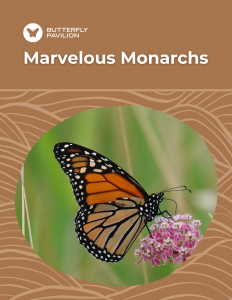Marvelous Monarchs
3rd-8th Grade
Cost: $5
Through interactive activities, students explore monarch anatomy, life cycles, and their extraordinary migration journey. This lesson emphasizes the ecological importance of monarch butterflies, addresses common misconceptions, and explores the challenges they face, such as habitat loss and climate change. Students gain an appreciation for monarchs’ cultural significance and are empowered to engage in conservation efforts like planting milkweed and participating in community science projects. This program aims to foster curiosity and action to protect these vital pollinators.

Redistribution Policy:
Nothing in this lesson plan may be copied or reproduced without written permission from Butterfly Pavilion, except for student worksheets, which may be reproduced for educational use in connection with the activities provided.
Tax Exemption
If you are purchasing with a tax-exempt card, please reach out to education@butterflies.org so that we can exclude tax from your purchase.
Questions?
For questions about our downloadable lesson plans, email us at education@butterflies.org. Email is the best way to reach the Registrar.
If you prefer to speak by phone, call us at 720-974-1861.
Next Generation Science Standards Supported:
- 3-LS4-3 Construct an argument with evidence that in a particular habitat some organisms can survive well, some survive less well, and some cannot survive at all.
- 4-LS1-1 Construct an argument that plants and animals have internal and external structures that function to support survival, growth, behavior, and reproduction.
- 5-ESS3-1 Obtain and combine information about ways individual communities use science ideas to protect the Earth’s resources and environment.
- MS-LS2-1 Analyze and interpret data to provide evidence for the effects of resource availability on organisms and populations of organisms in an ecosystem.
- MS-LS2-4 Construct an argument supported by empirical evidence that changes to physical or biological components of an ecosystem affect populations.
- MS-LS2-5 Evaluate competing design solutions for maintaining biodiversity and ecosystem services.
- MS-ESS3-3 Apply scientific principles to design a method for monitoring and minimizing a human impact on the environment.


